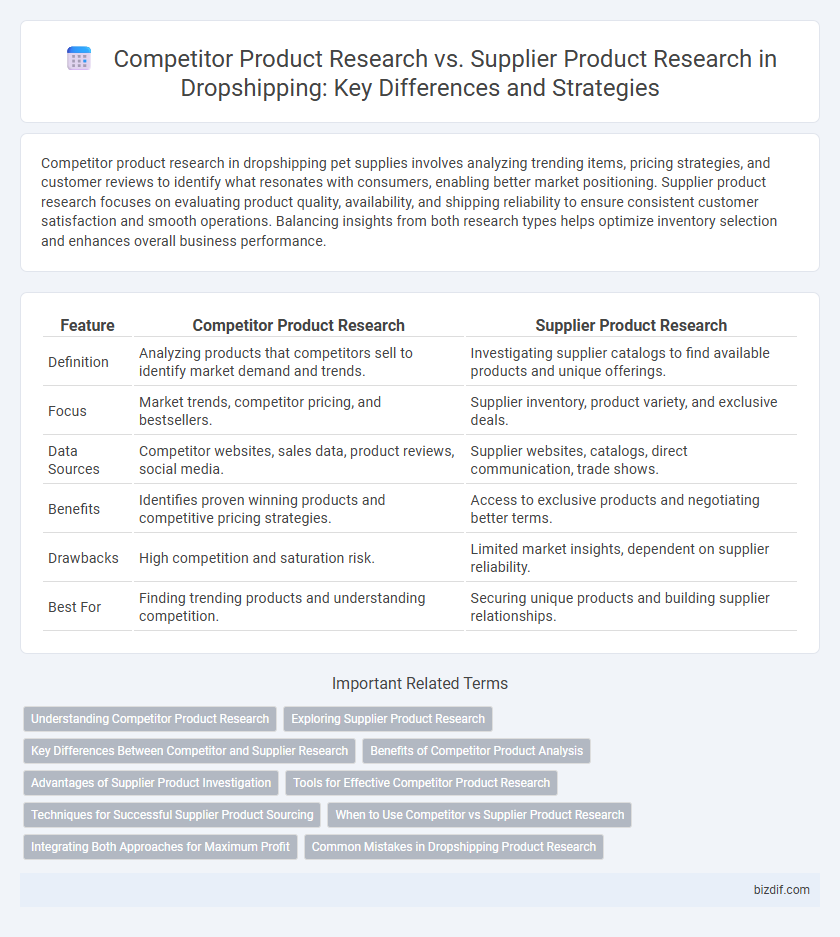Competitor product research in dropshipping pet supplies involves analyzing trending items, pricing strategies, and customer reviews to identify what resonates with consumers, enabling better market positioning. Supplier product research focuses on evaluating product quality, availability, and shipping reliability to ensure consistent customer satisfaction and smooth operations. Balancing insights from both research types helps optimize inventory selection and enhances overall business performance.
Table of Comparison
| Feature | Competitor Product Research | Supplier Product Research |
|---|---|---|
| Definition | Analyzing products that competitors sell to identify market demand and trends. | Investigating supplier catalogs to find available products and unique offerings. |
| Focus | Market trends, competitor pricing, and bestsellers. | Supplier inventory, product variety, and exclusive deals. |
| Data Sources | Competitor websites, sales data, product reviews, social media. | Supplier websites, catalogs, direct communication, trade shows. |
| Benefits | Identifies proven winning products and competitive pricing strategies. | Access to exclusive products and negotiating better terms. |
| Drawbacks | High competition and saturation risk. | Limited market insights, dependent on supplier reliability. |
| Best For | Finding trending products and understanding competition. | Securing unique products and building supplier relationships. |
Understanding Competitor Product Research
Understanding competitor product research in dropshipping involves analyzing top-selling items, pricing strategies, and customer reviews to identify market trends and demand patterns. This research provides insights into product performance and helps optimize your own offerings for competitive advantage. Competitor analysis focuses on external market behavior, unlike supplier product research which centers on product availability and quality.
Exploring Supplier Product Research
Exploring supplier product research in dropshipping involves analyzing the supplier's catalog to identify trending, high-demand products with consistent availability and competitive pricing. This approach helps streamline inventory management by ensuring reliable stock levels and faster shipping times, which enhances customer satisfaction. Leveraging supplier insights also enables dropshippers to discover unique or exclusive products that differentiate their store from competitors relying solely on competitor product research.
Key Differences Between Competitor and Supplier Research
Competitor product research focuses on analyzing market trends, pricing strategies, and customer preferences by studying direct competitors' offerings to identify gaps and opportunities for differentiation. Supplier product research emphasizes evaluating product quality, reliability, shipping times, and supplier reputation to ensure inventory consistency and customer satisfaction in the dropshipping supply chain. Understanding these distinctions enables dropshippers to balance market demand insights with operational feasibility for optimized product selection and business growth.
Benefits of Competitor Product Analysis
Competitor product research provides valuable insights into market trends, customer preferences, and pricing strategies, enabling dropshippers to identify high-demand products with proven sales potential. Analyzing competitors helps uncover gaps in product offerings and opportunities for differentiation, leading to more targeted marketing and improved conversion rates. This approach reduces the risk of investing in unsellable inventory by leveraging real-time competitive data and consumer feedback.
Advantages of Supplier Product Investigation
Supplier product research offers direct insights into product quality, pricing, and availability, enabling more accurate cost analysis and inventory management. Access to supplier data allows dropshippers to identify unique or exclusive items and negotiate better terms, enhancing competitive advantage. This approach reduces risks related to stockouts and shipping delays by establishing reliable communication channels with suppliers.
Tools for Effective Competitor Product Research
Effective competitor product research tools such as Jungle Scout, Helium 10, and SimilarWeb provide detailed insights into market trends, sales data, and competitor pricing strategies, enabling dropshippers to identify high-demand products and gaps in the market. These platforms analyze customer reviews, traffic sources, and keyword rankings to optimize product selection and marketing efforts. Leveraging such tools ensures a strategic advantage over supplier product research, which often lacks competitive market intelligence and focuses primarily on inventory and pricing.
Techniques for Successful Supplier Product Sourcing
Effective supplier product sourcing relies on techniques such as direct communication with manufacturers, analyzing supplier catalogs, and requesting samples to evaluate quality and reliability. Utilizing data-driven tools to assess supplier credibility and track inventory levels ensures consistent stock availability. Comparing supplier offerings based on pricing, shipping times, and product variations enhances decision-making for dropshipping success.
When to Use Competitor vs Supplier Product Research
Competitor product research is essential when identifying trending items and understanding market demand by analyzing top sellers and pricing strategies within your niche. Supplier product research is most useful for discovering unique, high-quality products with reliable inventory and favorable shipping terms to ensure smooth order fulfillment. Use competitor research during initial market exploration and supplier research when finalizing product selection and building relationships for inventory sourcing.
Integrating Both Approaches for Maximum Profit
Analyzing competitor product research identifies trending items and pricing strategies, while supplier product research uncovers high-margin products and reliable inventory sources. Integrating both approaches maximizes profit by aligning market demand insights with supplier capabilities, ensuring competitive pricing and consistent stock availability. Leveraging data from competitors and suppliers enables informed decisions, optimizing product selection and boosting overall dropshipping success.
Common Mistakes in Dropshipping Product Research
Dropshipping product research often falters when merchants confuse competitor product research with supplier product research, leading to misguided inventory choices. Relying solely on competitor analysis risks saturating the market with overhyped or low-margin items, while neglecting supplier product research can result in unreliable stock and fulfillment issues. Effective dropshipping strategies balance detailed competitor trends with thorough supplier evaluations, avoiding common mistakes such as ignoring product quality or supplier credibility.
Competitor Product Research vs Supplier Product Research Infographic

 bizdif.com
bizdif.com